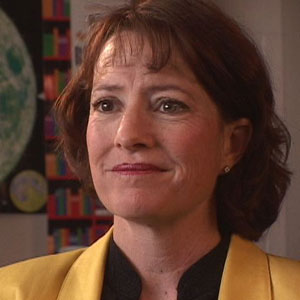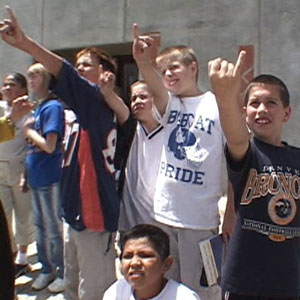Join us for conversations that inspire, recognize, and encourage innovation and best practices in the education profession.
Available on Apple Podcasts, Spotify, Google Podcasts, and more.
 “Naaba Ani is a Navajo term for a safe haven or a cave or a place of refuge and these kids — we have a lot of kids from very difficult backgrounds, dysfunctional life outside of school, so when they come here we want them to be — number one, know that the teachers are here for them, that we’re the same all the time, we’ve got some structure to the day but it’s intellectually safe so they feel safe enough to venture out with their thoughts and ideas. And when you get them to that point, then learning is really going to take off.”
“Naaba Ani is a Navajo term for a safe haven or a cave or a place of refuge and these kids — we have a lot of kids from very difficult backgrounds, dysfunctional life outside of school, so when they come here we want them to be — number one, know that the teachers are here for them, that we’re the same all the time, we’ve got some structure to the day but it’s intellectually safe so they feel safe enough to venture out with their thoughts and ideas. And when you get them to that point, then learning is really going to take off.”
Kathy Price’s first job out of college was at a preschool for handicapped children in the Four Corners region in New Mexico. She was tossed into the deep end: “I was told, here’s a program, here are some students, we don’t have a curriculum, so do whatever you want. So my first year out, I had to hire a speech pathologist, a physical therapist, another teacher, and an aide, and I had to learn about special education because I didn’t have a background in it.” She believes that experience made her more proactive in the schools she’s worked in. Now, 26 years later, Kathy is becoming a math and science specialist, and will be mentoring new teachers throughout her district.
Kathy has taught fourth and fifth grade the Naaba Ani Elementary School for 15 years, and has worked at Bloomington-area schools for a total of 21 years. She feels strongly about the importance of having a direct relationship with her students: “This is a very diverse class and it’s important for all to feel welcome, to feel that they have to have a personal relationship with the teacher and feel safe enough and secure enough that they know they won’t look stupid. Kids like teachers that like them. ”
 Lesson at a Glance:
Lesson at a Glance:
Curriculum: Project ARIES
Grade: 4-6
Topic: Moon’s distance from Earth
Kathy taught a lesson from Project ARIES, an astronomy-based elementary-level curriculum that she’s been working with since 1993, when she was asked to help pilot it with her students. “Project ARIES… gives the kids a reason to read, and they keep a journal, so they have a reason to write, so it incorporates a lot of our language arts skills and we have math right there too, especially with the scale and distance.”
The subject of the lesson was the Moon’s size and its distance from the Earth. In preparation for the lesson, Kathy had her students keep Moon journals in which they note the Moon’s shape, its location in the sky, and its distance from the horizon. She also engaged her students in informal discussions about the Moon — what did they know about it, how did they think it worked — and recorded their ideas.
In the first part of the lesson, the students, working in pairs, selected two balls or balloons that they felt represented the relative sizes of the Moon and Earth, and then stood a distance apart from one another that they felt represented the relative distance of the Moon from the Earth. After measuring that distance, the students took their objects outside, and Kathy explained how they could measure the angular size of the Moon with their pinky fingers, which is about half a degree. Kathy then had the students who were holding the model Earths stand against a wall while their partners, who were holding the model Moons, backed up until the model Moons appear as half a degree in angular size—that is, the same size as the real moon. Then, Kathy gave them a chance to trade the size of their objects, and had them work out how far away the Moon was from the Earth in Earth diameters.
After the lesson, Kathy observed, “In the first model they made, the Earth and Moon were very close together, and it wasn’t until they used angular size that they realized, that’s a lot farther than I thought. That’s a hard concept for them to gather… and it’s not something you can just tell kids, because they have no conception those kinds of distances and sizes.”
Kathy wanted her students to take three things from the lesson: that the distance to the Moon is farther away than the students thought it was; that the Moon is one-fourth the size of the Earth in diameter; and that the Earth is about 30 diameters away from the Moon.